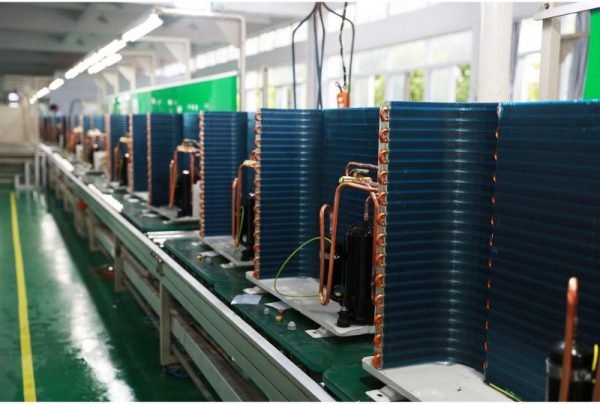Ecco le temperature comunemente usate per unità di refrigerazione. Devi capirli e prestare attenzione alle loro differenze durante la manutenzione quotidiana.
Temperatura di scarico
La temperatura di scarico (noto anche come temperatura di scarico) dell'unità di refrigerazione si riferisce alla temperatura del refrigerante mentre esce dal compressore. Questo è un parametro critico nei sistemi di refrigerazione, poiché riflette lo stato termico del refrigerante dopo la compressione. La temperatura di scarico è generalmente nell'intervallo di 50° C ~ 120 ° C. (122° F ~ 248 ° F.).
Alte temperature di scarico possono indicare potenziali problemi come:
1. Surriscaldamento: Può danneggiare il compressore o portare a lubrificante degradazione.
2. Livello del refrigerante errato: Troppo o troppo poco refrigerante può influire sull'efficienza del sistema.
3. Scarso scambio di calore: Dissipazione di calore inefficiente nel condensatore può aumentare la temperatura di scarico.
4. Surriscaldamento ad alta aspirazione: Il surriscaldamento eccessivo all'ingresso del compressore può portare ad alte temperature di scarico.
Temperatura del guscio del compressore
La temperatura del guscio del compressore si riferisce alla temperatura superficiale esterna dell'involucro di un compressore durante il funzionamento. È un indicatore del calore generato all'interno del compressore a seguito di lavori meccanici e compressione del refrigerante.
I fattori chiave influenzano Compressore Temperatura del guscio
1. Carico del compressore: Carichi più alti possono portare ad un aumento dell'attrito interno e del calore.
2. Temperatura ambiente: L'ambiente circostante può influenzare l'efficienza di raffreddamento del compressore.
3. Caratteristica del refrigerante: Il tipo e la condizione del refrigerante influenzano le caratteristiche termiche del sistema.
4. Efficienza del sistema: Problemi come la scarsa lubrificazione, Filtri intasati, o un raffreddamento inadeguato può aumentare la temperatura del guscio.
Gamme normali: La temperatura del guscio varia in base alla progettazione e al sistema ma è inferiore alla temperatura di scarico. Per la maggior parte dei sistemi, La temperatura del guscio può variare tra 40° C ~ 90 ° C. (104° F ~ 194 ° F.). È importante rimanere all'interno dei produttori’ limiti consigliati per evitare il surriscaldamento e potenziali danni al compressore.
La temperatura regolare del guscio del monitor può aiutare a rilevare i primi segni di inefficienza o guasto nel sistema di refrigerazione.
Temperatura di condensa
La temperatura di condensa si riferisce alla temperatura alla quale il refrigerante Modifiche dal vapore allo stato del liquido nel condensatore durante il ciclo di refrigerazione. Ciò si verifica sotto una pressione specifica, noto come pressione di condensa, che è determinato dalla progettazione del sistema e dalle condizioni operative.
Condensazione della temperatura di portata
Condensatore raffreddato ad aria
Esigenze di temperatura di condensa 10° C ~ 15 ° C. (18° F ~ 27 ° F.) superiore alla temperatura ambiente.
Per esempio, Se la temperatura ambiente è di 30 ° C (86°F), La temperatura di condensa vanno da 40° C ~ 45 ° C. (104° F ~ 113 ° F.).
Condensatore raffreddato ad acqua
Esigenze di temperatura di condensa 3° C ~ 8 ° C. (5° F ~ 15 ° F.) superiore alla temperatura dell'acqua di ingresso.
Per esempio, Se la temperatura di ingresso dell'acqua di raffreddamento è di 25 ° C (77°F), La temperatura di condensa vanno da 28° C ~ 33 ° C. (82° F ~ 91 ° F.).
Punti chiave sulla temperatura di condensa
1. Relazione con il rifiuto del calore: La temperatura di condensazione riflette il punto in cui il refrigerante rilascia calore nell'ambiente circostante (aria o acqua) nel condensatore.
2. Efficienza del sistema: Una temperatura di condensazione ottimale è cruciale per mantenere l'efficienza del sistema. Temperature elevate di condensazione possono indicare un trasferimento di calore scarso o prestazioni del condensatore inadeguate.
Temperatura del guscio del condensatore
La temperatura del guscio del condensatore si riferisce alla temperatura superficiale dell'involucro del condensatore o del guscio esterno durante il funzionamento. Questa temperatura indica quanto effettivamente il condensatore dissipa il calore assorbito dal refrigerante nell'ambiente circostante.
Di solito è leggermente al di sopra della temperatura dell'aria ambiente, ca. 2° C ~ 15 ° C. (4° F ~ 27 ° F.) più alto.
Punti chiave sulla temperatura del guscio del condensatore
1. Indicatore di rifiuto del calore: La temperatura del guscio riflette il trasferimento di calore che si verifica all'interno del condensatore. Dovrebbe essere inferiore alla temperatura di condensa del refrigerante.
2. Fattori influenzanti:
Condizioni ambientali–Temperature di aria ambiente o acqua più elevate possono aumentare la temperatura del guscio nei sistemi raffreddati all'aria o raffreddati ad acqua.
Efficienza del condensatore–Sporco, Fouling, o un flusso d'aria scarso può portare a un trasferimento di calore inefficiente e temperature di guscio elevate.
Pressione e carico del refrigerante–Il carico eccessivo del sistema o la pressione del refrigerante possono aumentare il calore interno, influire sulla temperatura del guscio.
Temperatura del ricevitore
La temperatura del ricevitore si riferisce alla temperatura del refrigerante immagazzinato in ricevitore liquido di un sistema di refrigerazione. Il ricevitore liquido è una nave situata dopo il condensatore, può conservare e regolare la fornitura di refrigerante liquido alla valvola di espansione o altri componenti a valle.
Punti chiave sulla temperatura del ricevitore
1. Relazione con la temperatura di condensa
La temperatura del ricevitore è vicina alla temperatura di condensazione poiché il refrigerante nel ricevitore è in uno stato liquido saturo o sottoinvolto.
Può essere poco inferiore alla temperatura di condensazione se si verifica il sottobicchi prima che il refrigerante entri nel ricevitore.
2. Indicatore di funzionamento del sistema
Le normali temperature del ricevitore indicano il corretto funzionamento del sistema, con una sufficiente rimozione del calore nel condensatore.
Le temperature aumentate potrebbero suggerire problemi come un raffreddamento del condensatore insufficiente o condizioni ambientali elevate.
3. Intervallo di temperatura
Per sistemi raffreddati ad aria, La temperatura del ricevitore è 5° C ~ 10 ° C. (9° F ~ 18 ° F.) Sotto la temperatura di condensa.
Per sistemi raffreddati ad acqua, La differenza può essere più piccola a causa di una migliore efficienza di raffreddamento.
Temperatura del filtro
La temperatura del filtro si riferisce alla temperatura del refrigerante mentre passa attraverso il filtro o filtro-asciutto in un sistema di refrigerazione. Filter-Drier è un componente utilizzato per rimuovere l'umidità, sporco, e altri contaminanti dal refrigerante per proteggere il sistema e garantire un funzionamento efficiente.
Punti chiave sulla temperatura del filtro
1. Stato refrigerante
Il refrigerante che passa attraverso il filtro è in uno stato liquido o sottoinvolto sul lato ad alta pressione del sistema.
In alcuni sistemi, Può anche gestire il refrigerante di vapore sul lato a bassa pressione.
2. Intervallo di temperatura normale
La temperatura del filtro dovrebbe essere vicina alla temperatura del liquido sottoposse del refrigerante.
Suo 5° C ~ 10 ° C. (9° F ~ 18 ° F.) inferiore alla temperatura di condensa.
3. Indicazioni di temperatura anormale
Il calo della temperatura attraverso il filtro può indicare un blocco parziale causato dallo sporco, ghiaccio, o detriti.
L'aumento della temperatura potrebbe suggerire problemi di flusso del refrigerante o un componente surriscaldato a causa delle inefficienze del sistema.
Temperatura di aspirazione
Temperatura di aspirazione (o temperatura di ingresso) si riferisce alla temperatura del refrigerante mentre entra nel compressore attraverso la linea di aspirazione in un sistema di refrigerazione. Questa temperatura è un parametro critico per le prestazioni del sistema e la salute del compressore.
Punti chiave sulla temperatura di aspirazione
1. Relazione con lo stato refrigerante
Refrigerant is in a superheated vapor state to ensure no liquid refrigerant enters compressor, which could cause damage.
2. Intervallo di temperatura normale
Suction temperature is little higher than evaporator temperature due to the addition of superheat.
Typical superheat values range from 5°C to 15°C (9°F to 27°F).
3. Importance of Monitor
Low Suction Temperature: Indicates insufficient superheat, risking liquid refrigerant entering the compressor ( known as “liquid slugging”).
High Suction Temperature: Suggests excessive superheat, which can reduce system efficiency and overheat the compressor.
TXV Temperature
The temperature associated with a thermostatic expansion valve (TXV) refers to the temperature of the refrigerant or the surrounding area that the valve controls and senses. TXV regola il flusso del refrigerante nell'evaporatore in base al surriscaldamento del refrigerante che lascia l'evaporatore.
Temperature chiave nell'operazione di TXV
1. Temperatura del sensore
Il sensore, Attaccata alla linea di aspirazione all'uscita dell'evaporatore, Misura la temperatura del refrigerante.
Questa temperatura determina il surriscaldamento e controlla il flusso del refrigerante aperto o vicino al TXV.
Normalmente 5° C ~ 15 ° C. (9° F ~ 27 ° F.) Sopra la temperatura satura dell'evaporatore.
2. Temperatura del refrigerante all'ingresso TXV
La temperatura del refrigerante che entra nel TXV è la temperatura del liquido sottoinvolta, che dovrebbe essere poco inferiore alla temperatura di condensa.
Generalmente 5° C ~ 10 ° C. (9° F ~ 18 ° F.) al di sotto della temperatura di condensa.
3. Temperatura del refrigerante all'uscita TXV
Dopo aver attraversato il TXV, La temperatura del refrigerante diminuisce significativamente a causa dell'espansione, Raggiungere la temperatura satura dell'evaporatore.
Generalmente 5° C ~ 10 ° C. (9° F ~ 18 ° F.) al di sotto della temperatura di condensa.
Temperatura di evaporazione
Temperatura di evaporazione (noto anche come temperatura evaporante o satura) si riferisce alla temperatura alla quale il refrigerante cambia da liquido a vapore all'interno dell'evaporatore di un sistema di refrigerazione.
Punti chiave sulla temperatura di evaporazione
1. Relazione con lo stato refrigerante
Alla temperatura di evaporazione, Il refrigerante assorbe il calore dall'ambiente e transizioni dal liquido a vapore.
2. Determinato dalla pressione dell'evaporatore
La temperatura di evaporazione corrisponde alla temperatura di saturazione alla pressione data all'interno dell'evaporatore. Questa relazione dipende dal tipo di refrigerante utilizzato.
Intervallo di temperatura
La temperatura di evaporazione è di solito 5° C ~ 10 ° C. (9° F ~ 18 ° F.) al di sotto della temperatura target del mezzo si raffredda (per esempio., aria o acqua).
Per aria condizionata sistema, la gamma è 2° C ~ 10 ° C. (36° F ~ 50 ° F.).
Per bassa temperatura sistemi di refrigerazione, Può essere basso come -40° C ~ -10 ° C. (-40° F ~ 14 ° F.).
Temperatura ambiente esterna
La temperatura ambiente esterna si riferisce alla temperatura al di fuori di un sistema di refrigerazione o di refrigerazione. È la temperatura esterna dell'ambiente in cui opera il sistema, e svolge un ruolo significativo nelle prestazioni dell'attrezzatura come condensatori raffreddati ad aria o unità esterne di HVAC e sistemi di refrigerazione.
Punti chiave sulla temperatura ambiente esterna
1. Impatto sulle prestazioni del condensatore
Nei sistemi raffreddati ad aria, La temperatura ambiente esterna influisce direttamente sull'efficienza del condensatore. Una temperatura ambiente più elevata può ridurre la capacità del condensatore di rifiutare il calore, portare a pressioni e temperature di scarico più elevate.
2. Carico di sistema
La temperatura esterna influenza il carico di raffreddamento complessivo del sistema. Per esempio, in tempo caldo, Le esigenze di raffreddamento sono più alte, che può influire sulle prestazioni di refrigerazione e sistemi di aria condizionata.
3. Variazione stagionale
La temperatura ambiente fluttua con le stagioni, caldo in estate e freddo in inverno. I sistemi devono gestire queste variazioni in modo efficace.
4. Intervallo di temperatura normale
La gamma di temperature esterne può variare notevolmente a seconda della posizione geografica e delle stagioni, ma normalmente, può variare -10°C (14°F) in inverno a +40°C (104°F) o superiore durante l'estate in molte regioni.
5. Importanza nel dimensionamento e nel funzionamento del sistema
Gli ingegneri considerano la temperatura ambiente esterna quando progettano sistemi HVAC e di refrigerazione per garantire che possano funzionare in modo efficiente in condizioni di temperatura elevata e bassa.
Conclusione
Queste temperature sono influenzate da fattori come le condizioni ambientali, Progettazione del sistema, Tipo di refrigerante,eccetera.
Selezione e manutenzione adeguate Le temperature sono cruciali per ottimizzare l'efficienza energetica, Garantire la longevità del sistema, e soddisfare requisiti specifici di raffreddamento o congelamento.
Eventuali commenti?
Benvenuto, lascia un messaggio o ripubblicalo.














